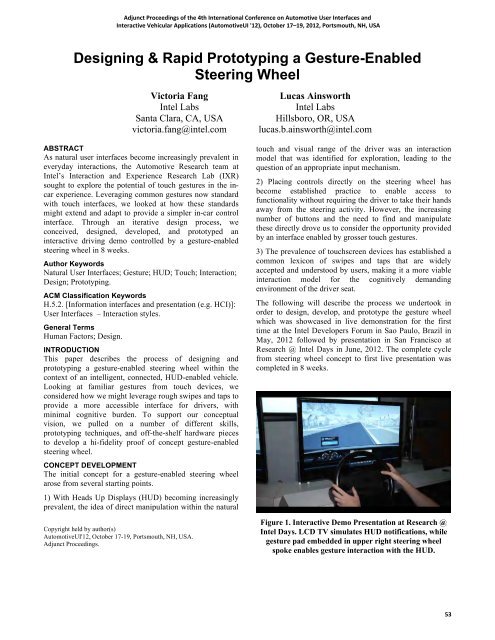12: Adjunct Proceedings - Automotive User Interfaces and ...
12: Adjunct Proceedings - Automotive User Interfaces and ...
12: Adjunct Proceedings - Automotive User Interfaces and ...
Create successful ePaper yourself
Turn your PDF publications into a flip-book with our unique Google optimized e-Paper software.
Designing & Rapid Prototyping a Gesture-Enabled<br />
Steering Wheel<br />
Victoria Fang<br />
Intel Labs<br />
Santa Clara, CA, USA<br />
victoria.fang@intel.com<br />
ABSTRACT<br />
As natural user interfaces become increasingly prevalent in<br />
everyday interactions, the <strong>Automotive</strong> Research team at<br />
Intel’s Interaction <strong>and</strong> Experience Research Lab (IXR)<br />
sought to explore the potential of touch gestures in the incar<br />
experience. Leveraging common gestures now st<strong>and</strong>ard<br />
with touch interfaces, we looked at how these st<strong>and</strong>ards<br />
might extend <strong>and</strong> adapt to provide a simpler in-car control<br />
interface. Through an iterative design process, we<br />
conceived, designed, developed, <strong>and</strong> prototyped an<br />
interactive driving demo controlled by a gesture-enabled<br />
steering wheel in 8 weeks.<br />
Author Keywords<br />
Natural <strong>User</strong> <strong>Interfaces</strong>; Gesture; HUD; Touch; Interaction;<br />
Design; Prototyping.<br />
ACM Classification Keywords<br />
H.5.2. [Information interfaces <strong>and</strong> presentation (e.g. HCI)]:<br />
<strong>User</strong> <strong>Interfaces</strong> – Interaction styles.<br />
General Terms<br />
Human Factors; Design.<br />
<strong>Adjunct</strong> <strong>Proceedings</strong> of the 4th International Conference on <strong>Automotive</strong> <strong>User</strong> <strong>Interfaces</strong> <strong>and</strong><br />
Interactive Vehicular Applications (<strong>Automotive</strong>UI '<strong>12</strong>), October 17–19, 20<strong>12</strong>, Portsmouth, NH, USA<br />
INTRODUCTION<br />
This paper describes the process of designing <strong>and</strong><br />
prototyping a gesture-enabled steering wheel within the<br />
context of an intelligent, connected, HUD-enabled vehicle.<br />
Looking at familiar gestures from touch devices, we<br />
considered how we might leverage rough swipes <strong>and</strong> taps to<br />
provide a more accessible interface for drivers, with<br />
minimal cognitive burden. To support our conceptual<br />
vision, we pulled on a number of different skills,<br />
prototyping techniques, <strong>and</strong> off-the-shelf hardware pieces<br />
to develop a hi-fidelity proof of concept gesture-enabled<br />
steering wheel.<br />
CONCEPT DEVELOPMENT<br />
The initial concept for a gesture-enabled steering wheel<br />
arose from several starting points.<br />
1) With Heads Up Displays (HUD) becoming increasingly<br />
prevalent, the idea of direct manipulation within the natural<br />
Copyright held by author(s)<br />
<strong>Automotive</strong>UI'<strong>12</strong>, October 17-19, Portsmouth, NH, USA.<br />
<strong>Adjunct</strong> <strong>Proceedings</strong>.<br />
Lucas Ainsworth<br />
Intel Labs<br />
Hillsboro, OR, USA<br />
lucas.b.ainsworth@intel.com<br />
touch <strong>and</strong> visual range of the driver was an interaction<br />
model that was identified for exploration, leading to the<br />
question of an appropriate input mechanism.<br />
2) Placing controls directly on the steering wheel has<br />
become established practice to enable access to<br />
functionality without requiring the driver to take their h<strong>and</strong>s<br />
away from the steering activity. However, the increasing<br />
number of buttons <strong>and</strong> the need to find <strong>and</strong> manipulate<br />
these directly drove us to consider the opportunity provided<br />
by an interface enabled by grosser touch gestures.<br />
3) The prevalence of touchscreen devices has established a<br />
common lexicon of swipes <strong>and</strong> taps that are widely<br />
accepted <strong>and</strong> understood by users, making it a more viable<br />
interaction model for the cognitively dem<strong>and</strong>ing<br />
environment of the driver seat.<br />
The following will describe the process we undertook in<br />
order to design, develop, <strong>and</strong> prototype the gesture wheel<br />
which was showcased in live demonstration for the first<br />
time at the Intel Developers Forum in Sao Paulo, Brazil in<br />
May, 20<strong>12</strong> followed by presentation in San Francisco at<br />
Research @ Intel Days in June, 20<strong>12</strong>. The complete cycle<br />
from steering wheel concept to first live presentation was<br />
completed in 8 weeks.<br />
Figure 1. Interactive Demo Presentation at Research @<br />
Intel Days. LCD TV simulates HUD notifications, while<br />
gesture pad embedded in upper right steering wheel<br />
spoke enables gesture interaction with the HUD.<br />
53





